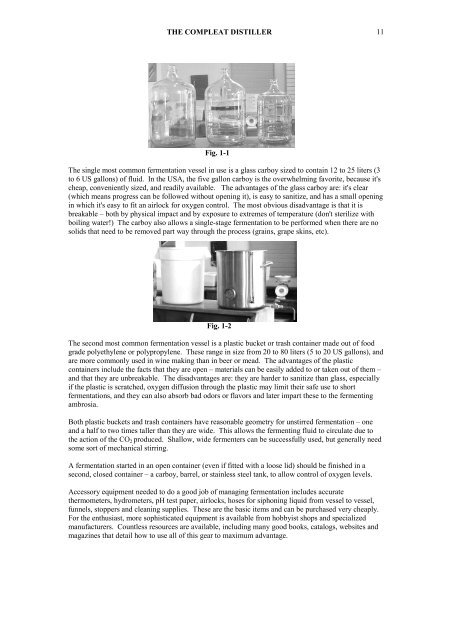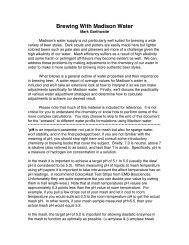The Compleat Distiller
The Compleat Distiller
The Compleat Distiller
Create successful ePaper yourself
Turn your PDF publications into a flip-book with our unique Google optimized e-Paper software.
THE COMPLEAT DISTILLER 11<br />
Fig. 1-1<br />
<strong>The</strong> single most common fermentation vessel in use is a glass carboy sized to contain 12 to 25 liters (3<br />
to 6 US gallons) of fluid. In the USA, the five gallon carboy is the overwhelming favorite, because it's<br />
cheap, conveniently sized, and readily available. <strong>The</strong> advantages of the glass carboy are: it's clear<br />
(which means progress can be followed without opening it), is easy to sanitize, and has a small opening<br />
in which it's easy to fit an airlock for oxygen control. <strong>The</strong> most obvious disadvantage is that it is<br />
breakable – both by physical impact and by exposure to extremes of temperature (don't sterilize with<br />
boiling water!) <strong>The</strong> carboy also allows a single-stage fermentation to be performed when there are no<br />
solids that need to be removed part way through the process (grains, grape skins, etc).<br />
Fig. 1-2<br />
<strong>The</strong> second most common fermentation vessel is a plastic bucket or trash container made out of food<br />
grade polyethylene or polypropylene. <strong>The</strong>se range in size from 20 to 80 liters (5 to 20 US gallons), and<br />
are more commonly used in wine making than in beer or mead. <strong>The</strong> advantages of the plastic<br />
containers include the facts that they are open – materials can be easily added to or taken out of them –<br />
and that they are unbreakable. <strong>The</strong> disadvantages are: they are harder to sanitize than glass, especially<br />
if the plastic is scratched, oxygen diffusion through the plastic may limit their safe use to short<br />
fermentations, and they can also absorb bad odors or flavors and later impart these to the fermenting<br />
ambrosia.<br />
Both plastic buckets and trash containers have reasonable geometry for unstirred fermentation – one<br />
and a half to two times taller than they are wide. This allows the fermenting fluid to circulate due to<br />
the action of the CO 2 produced. Shallow, wide fermenters can be successfully used, but generally need<br />
some sort of mechanical stirring.<br />
A fermentation started in an open container (even if fitted with a loose lid) should be finished in a<br />
second, closed container – a carboy, barrel, or stainless steel tank, to allow control of oxygen levels.<br />
Accessory equipment needed to do a good job of managing fermentation includes accurate<br />
thermometers, hydrometers, pH test paper, airlocks, hoses for siphoning liquid from vessel to vessel,<br />
funnels, stoppers and cleaning supplies. <strong>The</strong>se are the basic items and can be purchased very cheaply.<br />
For the enthusiast, more sophisticated equipment is available from hobbyist shops and specialized<br />
manufacturers. Countless resources are available, including many good books, catalogs, websites and<br />
magazines that detail how to use all of this gear to maximum advantage.









